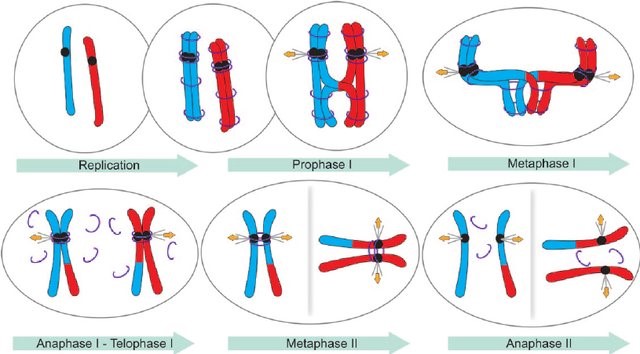
Chromosomes during meiosis:
- Meiosis division occurs during gametogenesis in higher organism (eukaryotic cells). The events of meiosis of a cell includes duplication of chromosomes which is followed by one reductional division and other equational division resulting into four haploid cells, each containing half the number of chromosomes.
- Meiosis consists of two rounds of chromosome segregation following a single replication.
- The phases of meiosis is divided into two; meiosis-I and meiosis-II.
- Before the onset of meiotic division, the chromosomes of the pre-gametic cell are replicated to yield two pairs of sister chromatids after which they enter a long meiotic prophase interval.
- This prophase-I is divided into five distinct stages which are termed as (a) leptotene, (b) zygotene, (c) pachytene, (d) diplotene, and (e) diakinesis
- In leptotene stage, the chromosomes condense along their axial elements.
- During the zygotene stage, the parental homologous chromosomes pair with the help of a structure known as the Synaptonemal complex (SC). These Synaptonemal complex have a tripartite structure, comprising a central element bounded by two lateral elements.
- The pachytene is the longest stage of the meiotic prophase, during which crossing over and genetic recombination takes place between the paired homologous chromosomes.
- In diplotene and diakinesis stages, nuclear membrane disappears and spindle fibres formations begins.
- Prophase I: chromosomes condense, undergo duplication and crossing over, and centrioles move to the poles
- Metaphase I: microtubules connect from the centrioles to the centromeres, and the paired chromosomes line up along the equator of the cell
- Anaphase I: paired chromosomes separate and are pulled to alternate poles
- Telophase I: chromosomes decondense, nuclear membrane and nucleolus forms, centrioles move back together
- Prophase II: chromosomes condense and centrioles move to the poles
- Metaphase II: microtubules connect from the centrioles to the centromeres, and the paired chromatids line up along the equator of the cell
- Anaphase II: paired chromatids separate and are pulled to alternate poles
- Telophase II: chromosomes decondense, nuclear membrane and nucleolus forms, centrioles move back together.
- With the separation of the parental chromosome pairs in the subsequent stages, the first meiotic division results in the reduction of chromosomes by half, which is followed by another division, analogous to mitosis to produce haploid gametes.
- During meiosis, replicated homologous chromosomes pair and engage in recombination and then segregate to opposite poles. Sister chromatids are separated at meiosis II, and four recombined haploid gametes are formed.
Cytological basis of segregation of alleles:
- The cytological basis of segregation of alleles can be explained if we take the example of an individual which possesses two allelomorphs ‘A’ and ‘a’ on two different homologous chromosomes i.e., A on one chromosome and a on the second chromosome.
- In the prophase stage the two chromosomes will pair and duplicate
- In meiosis-I, allele Aand allele a from homologouschromosome will segregate or separate from each other.
- In the meiosis-II, the two chromatids of A chromosomes and those of a chromosome separate. Thus it becomes clear that both alleles of heterozygote separate during meiosis (gametogenesis) to produce gametes with only one chromosome with either dominant allele or recessive allele.
- No gamete will have both the genes and chromosomes of an allelic pair.
Historically, there have been three general approaches for the study of meiosis,
- Morphological and cytological approaches
- Genetic approaches:
- Biochemical approaches: Characterization of the biochemical processes of meiosis.
1. Morphological and cytological approach:
- In this approach, morphological and cytological investigation of dividing cell was carried out and from these studies it was clear that chromosome behaves in certain ways during meiosis.
- From the behavior study of chromosome during prophase stage, it was found that chromosome comes together forming homologous pair which is brought together by a protein called synaptonemal complex.
- So, it is now very clear that these protein structures are an integral part of meiosis all living organisms.
2. Genetic approach:
- In genetic approach, from the study of several mutants such as yeast, Neurospora etc, it was found that several genes are responsible for meiosis process.
3. Biochemical approach:
- In this approach of characterizing biochemical processes in cell during meiosis, it was found that several enzymes and protein are responsible for chromosome pairing as well as DNA replication and other events.
- This approaches helps to characterized the role of enzymes and protein in DNA synthesis, chromosome pairing and in crossing over (recombination).
